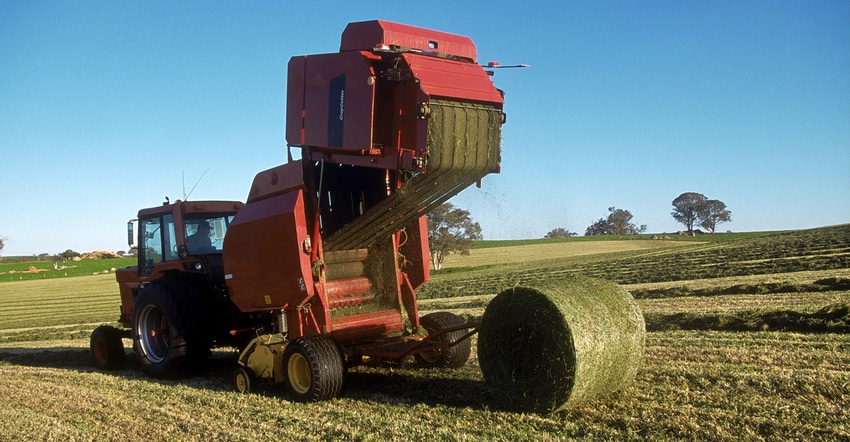August 23, 2022

Even with much of the Northern Plains receiving adequate rainfall this year, reports of round baler fires are still occurring.
“It seems odd to think about the risk of baler fires right now, as the grass is still green in many areas where hay is still being harvested,” says Tom Clays, North Dakota Forest Service director. “However, the amount of ‘fuel,’ or biomass, that is out there this year in the ditches, meadows and Conservation Reserve Program areas is substantial. There’s enough fuel out there that can easily catch fire with just one spark or overheated part, and quickly become out of control.”
Timely baler maintenance is key to prevent dangerous round baler fires.
“A common cause of round baler fires is mechanical issues, primarily problems with roller bearings found within the baler,” says Angie Johnson, North Dakota State University Extension farm and ranch safety coordinator. “The roller bearings inside the round baler can easily become damaged due to wear and extended use. Once the bearings are damaged, they become dangerously hot and can start a fire inside the baler chamber.”
As the haying season shifts into more mature and drier grasses, including the baling of small grain straw, these types of fuels can burn quickly and spread over a large area.
“We have to remember that there is a tremendous amount of friction and static that builds up during baling,” Johnson says. “Add that combination of friction and static electricity, or a mechanical failure on the baler, with extremely dry hay, and you have the perfect recipe to start a fire.”
Assess equipment before use
To prevent round baler fires this haying season, Johnson recommends conducting a visual assessment of the baler by walking around the baler when both it and the tractor are shut off. Performing preventive measures, including daily maintenance when in active use, can help farmers maintain their equipment for peak performance, reduce repairs and prevent equipment fires.
When assessing the rollers and belts inside the round baler, farmers may need to have the chamber door of the baler open. “Always make sure the chamber door is in the lock position by manually shifting the lever to the lock position,” Johnson says. “By locking the chamber door open, you prevent the possibility of the chamber door closing on you if the hydraulics of the chamber door fail.”
During the visual assessment of the baler, Johnson recommends farmers consider the following actions:
Inspect parts. Check bearings, chains, hoses and belts for wear and replace worn parts. Some balers use chains or drums rather than belts to create the bale.
Remove wrap and twine. Excess net wrap and twine may have accumulated around the rollers.
Examine shields. Look for purple discoloration on the shields of the baler where the roller bearings are located, as this could be a sign of a “hot spot” on the baler. These hot spots are indicators that the bearing might be wearing out and needs to be replaced.
Check belts. They may have become loose around the rollers. If a belt becomes too loose, the belt starts slipping on the rollers, causing friction. That friction can allow for dust particles, loose material and the bale developing inside the baler chamber to ignite.
Grease parts. Lubricate chains, gears and bearings following the recommended lubrication instruction schedule from your baler’s operator manual. The manual will provide the best maintenance schedule for your baler.
Blow off debris. Use an air compressor to blow dry matter, such as leaves, dust and plant stems, off the baler after every 50 to 75 bales.
An infrared heat thermometer is an inexpensive tool at $20 to $40, which can be found at farm and ranch supply stores to help prevent baler fires.
“An infrared heat thermometer is a great tool to help monitor the temperature of your baler’s roller bearings,” Johnson says. “Take the time for a stretch break while baling and use the thermometer to check the temperature of your baler’s roller bearings. If you see a temperature spike with one or more bearings, it is time to stop and get the bearing replaced before your baler becomes damaged and catches fire.”
Farmers should also carry a fire extinguisher and make sure it is full and working correctly, Johnson says.
“Let others know your plans before going out to bale hay, so if you don’t return when you said you would, someone can check to make sure you are OK,” she says. “This also means you should carry a fully charged cellphone with you while baling.”
In the event of a fire, immediately call 911. Firefighters can help contain the fire quickly and lessen the extent of the damage.
“A baler can be replaced. You can’t,” Johnson reminds farmers.
For more farm and ranch safety tips, visit ndsu.edu/agriculture.
Source: North Dakota State University Extension, which is solely responsible for the information provided and is wholly owned by the source. Informa Business Media and all its subsidiaries are not responsible for any of the content contained in this information asset.
You May Also Like




